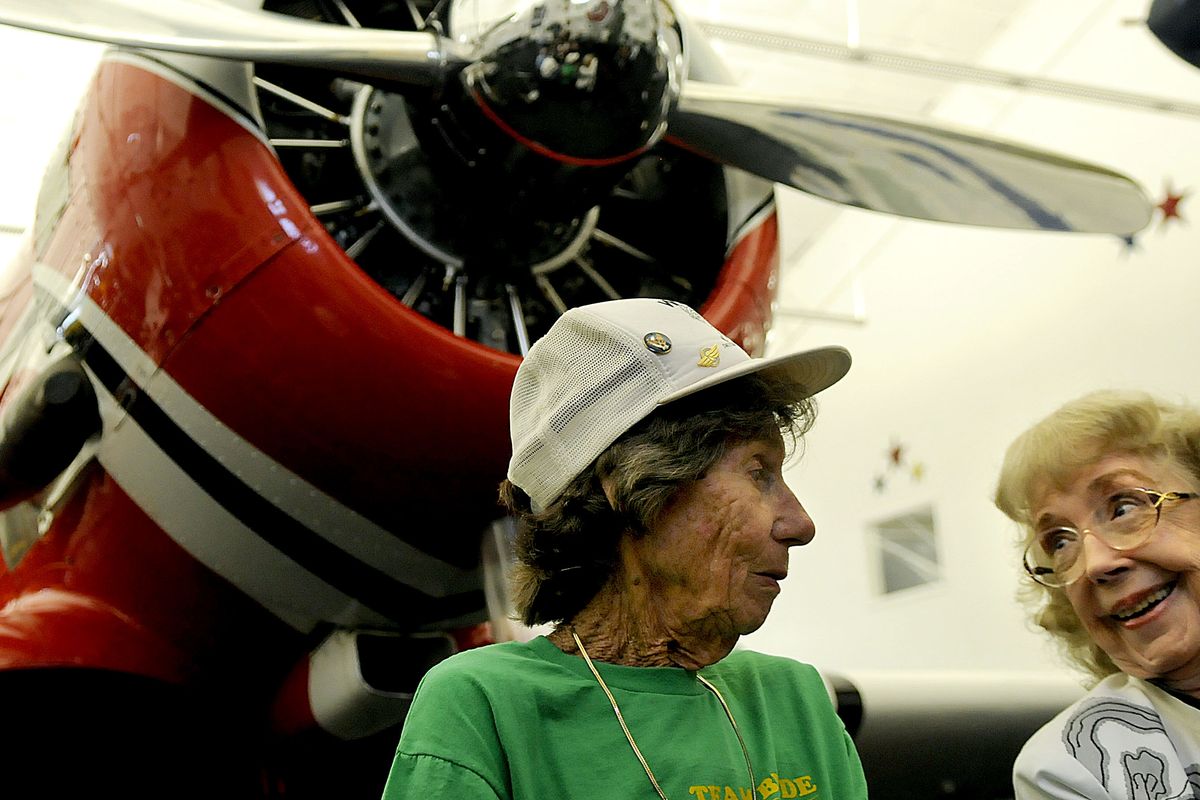Pilot program for equality
Museum event will honor female fliers of World War II

In 1943, Millicent Peterson Young gathered up her earnings from the wheat harvest, and ran away to learn how to fly.
World War II was in full swing, and the military had begun accepting women pilots. Young, a Nebraska farm girl, never doubted that she could qualify.
“By the time I was 10, I could drive a tractor, a truck and a car,” Young said. After flight lessons at an airstrip in Ogallala, Neb., she joined the Women Airforce Service Pilots.
More than 1,000 civilian women flew in noncombat missions for the Army Air Forces during the war. About 300 of the women pilots, also known as WASPs, are still alive. Their contribution to the war effort will be honored Saturday at the Bird Aviation Museum and Invention Center in Sagle, Idaho.
Young and her colleagues are an important but often overlooked part of the Greatest Generation, said Pamela Bird, who runs the museum with her husband, Dr. Forrest Bird. They were pioneers, helping pave the way for women to serve the military, she said.
For Young, who lives in Colorado, it was a time of patriotism and adventure.
In the 1940s, Army Air Forces faced a quandary. Thousands of airplanes were rolling off factory assembly lines, awaiting delivery to military bases, but most male pilots were flying combat missions overseas.
To help with the backlog, the government launched an experimental program to train women pilots. England and Russia were already using women to fly training aircraft and combat-style planes, but the idea was controversial in the United States.
“Young girls at that time were supposed to stay home and have babies,” said Alyce Stevenson Rohrer, an 86-year-old resident of Pasadena, Calif., who joined WASP after high school, despite parental disapproval.
Even the top military brass expressed doubts.
“Frankly, I didn’t know in 1941 whether a slip of a young girl could fight the controls of a B-17 in the heavy weather they would naturally encounter in operational flying,” Gen. Henry “Hap” Arnold, the Army Air Forces’ commanding general, said in a 1944 speech. “Those of us who had been flying for 20 or 30 years knew that flying an airplane was something you do not learn overnight.”
Arnold eventually became a staunch supporter of the program.
More than 25,000 women applied for the pilot training. About 1,800 were accepted at the program at Avenger Field, an all-female base in Sweetwater, Texas.
The women had to have at least 35 hours of flying experience to qualify for the training. And they were supposed to be 21 or older. Many lied about their age.
“No one checked my birth certificate,” said Rohrer, who had her pilot’s license at age 16. She grew up on a ranch next to a small airstrip in Provo, Utah.
Dawn Y. Seymour was studying home economics at Cornell University when a World War I pilot told her she’d be a good candidate for the program. “I fell in love with flying,” Seymour said. “I never figured that anything could be so full of joy.”
Avenger itself was a barren place. “I remember the dirt, the tumble weeds, the rattlesnakes and the wind,” Rohrer said.
But the chance to fly big airplanes was worth every bit of discomfort, the women said. Betty Budde’s favorite plane was a bomber called the A-25 Shrike.
“He was a Helldiver, big and powerful,” said Budde, who now lives in Concord, Calif. “Once you got into that, it was fun.”
About 1,000 women graduated from the seven-month program. They eventually flew more than 60 million miles in noncombat missions. Thirty-eight died while flying for the Army Air Forces.
Seymour was sent to an airfield in Florida, where recruits were trained to fire 50-caliber machine guns out of planes. Other female pilots ferried cargo, tested planes, trained male pilots and towed targets for artillery practice.
The program was disbanded in December 1944, when male pilots began returning from overseas. “I was heartbroken,” said Ruth Schumaker of Tucson, Ariz., who was training at Avenger when the decision was made.
Many of the women never had the opportunity to fly planes again. Rohrer became a high school English teacher, writing “Girls of Avenger,” a novel based on her experiences. Young sold encyclopedias door-to-door and later became a social worker. Schumaker entered the Marine Corps. The other women raised families.
Since they were hired under the Civil Service Commission, the WASPs didn’t receive veteran status and benefits until 1979. Later, their service was honored with military medals.
On Thursday, the women reminisced about their training days. Crosswinds and instrument landings figured into their memories, along with the guff they took from male pilots.
“It was well worth it,” Budde said. “We thought our service was something to be proud of.”